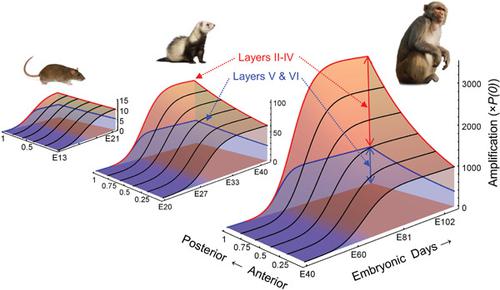当前位置:
X-MOL 学术
›
Evol. Dev.
›
论文详情
Our official English website, www.x-mol.net, welcomes your
feedback! (Note: you will need to create a separate account there.)
Developmental duration as an organizer of the evolving mammalian brain: scaling, adaptations, and exceptions.
Evolution and Development ( IF 2.6 ) Pub Date : 2019-12-03 , DOI: 10.1111/ede.12329 Barbara L Finlay 1 , Kexin Huang 2
Evolution and Development ( IF 2.6 ) Pub Date : 2019-12-03 , DOI: 10.1111/ede.12329 Barbara L Finlay 1 , Kexin Huang 2
Affiliation

|
Neurodevelopmental duration plays a central role in the evolution of the retina and neocortex in mammals. In the diurnal primate eye and retina, it is necessary to scale the number of cones versus the number of rods with different exponents to defend their respective functions of spatial acuity and sensitivity in eyes of different sizes. The order of photoreceptor precursor specification, cones specified first, rods second, couples their respective cell numbers at maturity to the kinetics of embryonic stem cell proliferation. Different durations of retinogenesis change the ratio of rods to cones produced so as to defend both functions over a range of eye diameters. In the evolution of nocturnality, the same coupling of photoreceptor specification to neurogenesis is altered to fewer cones and many more rods in nocturnal eyes, by delaying the onset of retinogenesis. Similarly, the neocortex also shows coupling of the specification of laminar position with duration of neurogenesis. Overall, duration of neurogenesis directly predicts neocortex volume in most mammalian clades. In larger brains with longer neocortical neurogenesis, its organization changes progressively, differentiating the frontal pole from the occipital pole in volume of connectivity and number of neurons per unit column. This permits greater, hierarchically organized information abstraction with increasing neocortex volume. Exceptions do exist, however, in species of three separate taxa, marsupials, naked mole rats, and bats, which break the correlation of neurodevelopmental duration and brain size. Naked mole rats and bats both have small brains and unusual longevity, coupled with neurodevelopmental periods characteristic of much bigger‐brained animals, raising the possibility that developmental duration and lifespan have some genetic or mechanistic control in common. The role of duration of development in mediating between the mechanistic levels of construction of retinal and cortical organization, and the different life histories associated with larger brains, such as duration of parental care, learning and overall longevity are discussed.
中文翻译:

作为不断发展的哺乳动物大脑的组织者的发展历程:缩放,适应和例外。
神经发育持续时间在哺乳动物视网膜和新皮层的进化中起着核心作用。在昼夜灵长类动物的眼睛和视网膜中,有必要对视锥细胞的数量与具有不同指数的视杆的数量进行标度,以捍卫它们在不同大小的眼睛中各自的空间敏锐度和敏感性功能。感光体前体规格的顺序(先指定圆锥,再指定杆)将成熟时其各自的细胞数与胚胎干细胞增殖的动力学联系起来。视网膜发生的不同持续时间会改变所产生的视杆与视锥的比例,从而在一定范围的眼睛直径内捍卫两种功能。在夜间活动的演变过程中,夜间眼睛中视锥细胞与神经发生的相同耦合改变为更少的视锥细胞和更多的视杆,通过延迟视网膜发生。同样,新皮层也显示出层状位置规范与神经发生持续时间的耦合。总体而言,神经发生的持续时间直接预测大多数哺乳动物进化枝中的新皮层体积。在具有更长的新皮层神经发生的较大大脑中,其组织逐渐变化,在连接量和每单位列的神经元数量方面使额叶与枕骨区分开。随着新皮层体积的增加,这可以实现更大的,层次化的组织信息抽象。但是,在三个独立的类群,有袋动物,裸mole鼠和蝙蝠的物种中确实存在例外,这打破了神经发育持续时间与大脑大小的相关性。裸mole鼠和蝙蝠大脑小,寿命长,再加上大脑动物所具有的神经发育时期,增加了发育持续时间和寿命具有共同的遗传或机制控制的可能性。讨论了发育持续时间在介导视网膜和皮层组织的机械构造水平以及与较大大脑相关的不同生活史(例如父母护理,学习和总体寿命)之间的中介作用。
更新日期:2019-12-03
中文翻译:

作为不断发展的哺乳动物大脑的组织者的发展历程:缩放,适应和例外。
神经发育持续时间在哺乳动物视网膜和新皮层的进化中起着核心作用。在昼夜灵长类动物的眼睛和视网膜中,有必要对视锥细胞的数量与具有不同指数的视杆的数量进行标度,以捍卫它们在不同大小的眼睛中各自的空间敏锐度和敏感性功能。感光体前体规格的顺序(先指定圆锥,再指定杆)将成熟时其各自的细胞数与胚胎干细胞增殖的动力学联系起来。视网膜发生的不同持续时间会改变所产生的视杆与视锥的比例,从而在一定范围的眼睛直径内捍卫两种功能。在夜间活动的演变过程中,夜间眼睛中视锥细胞与神经发生的相同耦合改变为更少的视锥细胞和更多的视杆,通过延迟视网膜发生。同样,新皮层也显示出层状位置规范与神经发生持续时间的耦合。总体而言,神经发生的持续时间直接预测大多数哺乳动物进化枝中的新皮层体积。在具有更长的新皮层神经发生的较大大脑中,其组织逐渐变化,在连接量和每单位列的神经元数量方面使额叶与枕骨区分开。随着新皮层体积的增加,这可以实现更大的,层次化的组织信息抽象。但是,在三个独立的类群,有袋动物,裸mole鼠和蝙蝠的物种中确实存在例外,这打破了神经发育持续时间与大脑大小的相关性。裸mole鼠和蝙蝠大脑小,寿命长,再加上大脑动物所具有的神经发育时期,增加了发育持续时间和寿命具有共同的遗传或机制控制的可能性。讨论了发育持续时间在介导视网膜和皮层组织的机械构造水平以及与较大大脑相关的不同生活史(例如父母护理,学习和总体寿命)之间的中介作用。











































 京公网安备 11010802027423号
京公网安备 11010802027423号